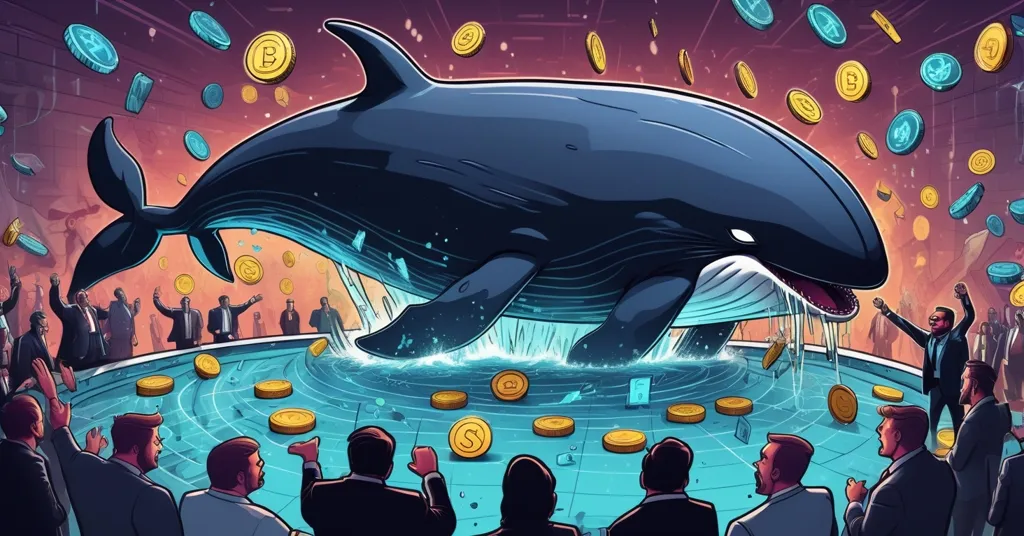Crypto Beast Denies ALT Rug Pull Involvement, Blames Whale Snipers for $175M Crash

Crypto Beast Denies Role in Altcoin (ALT) Rug Pull, Points Finger at Whale Snipers
Altcoin (ALT), a hyped-up meme token on the Solana blockchain, suffered a catastrophic rug pull on July 14, 2025, crashing 95% in value and wiping out over $175 million in notional worth in mere minutes. As holders reel from the devastation, accusations are flying at influencer Crypto Beast, whose relentless promotion of ALT has many questioning his role in the disaster. While he denies involvement and blames mysterious whale snipers, the crypto community isn’t buying it—and they’re out for answers.
- ALT Meltdown: Token plummeted from $180M market cap to under $5M in minutes.
- Crypto Beast’s Claim: Points to anonymous whales for raking in $2.2M via coordinated dumps.
- Community Outrage: Suspicions of manipulation grow, with an investigation team pushing for justice.
The ALT Implosion: A $175M Disaster Unfolds
On July 9, 2025, Altcoin (ALT) launched at a modest $0.018, riding the Solana blockchain’s wave of low-cost, high-speed transactions. Hosted on Raydium—a decentralized trading platform on Solana where liquidity pools power trading without traditional order books—ALT was primed for volatility. For the unversed, a rug pull in crypto is like a shared vault of funds that users deposit to facilitate trades; it’s a cornerstone of DeFi (decentralized finance) but a sitting duck for manipulation by large players, known as whales. Fueled by viral social media hype, ALT surged 10X in just days, hitting a staggering $180 million market cap. Then, on July 14, the bottom fell out. In under 30 minutes, the token nosedived to $0.003, erasing 95% of its value and shrinking its market cap to under $5 million. A classic rug pull had struck, leaving retail investors with nothing but digital ash.
A rug pull, in crypto lingo, is the ultimate betrayal: insiders or big holders dump their tokens en masse, draining the liquidity pool and tanking the price faster than a falling anvil. ALT’s collapse wasn’t just a bad day at the market—it was a calculated gut punch. On-chain data exposes the carnage, showing sniper wallets—accounts often using automated tools or insider timing to buy low and sell high—cashing out at the peak. These whales bought early, likely at launch prices, and orchestrated dumps that netted over $2.2 million in profits. That’s enough to buy a luxury yacht, siphoned off while small-time holders watched their savings vanish. One wallet, tagged as 8kpY, pocketed $535.6K, while another bagged $493.8K. Even more telling, these gains were funneled into a single Solana address holding 2.05M USDC (a stablecoin pegged to the dollar) and other meme assets, active since January 2025. The precision reeks of a planned heist, not a random market hiccup. For deeper insights into these transactions, check out this detailed analysis of ALT whale wallets on Solana.
Crypto Beast: Hype Man or Hidden Hand?
At the center of this firestorm stands Crypto Beast, a prominent influencer with a massive following on X under the handle @cryptobeastreal. In the days before the crash, he was ALT’s loudest cheerleader, flooding his feed with posts urging followers to jump on the rocket. When the token imploded, his initial response wasn’t contrition—it was a disappearing act. Crypto Beast temporarily deleted his X account, wiping out his prior ALT promotions in a move that screamed damage control. He later resurfaced with a defense that’s as flimsy as a paper umbrella in a hurricane. On July 15, he tweeted:
“An investigation into Altcoin (ALT) and why it dropped 85% in minutes: A sophisticated group of snipers, or ‘rug pullers’ has made over $2.2 million from ALT by buying early and selling slowly on the way up.” – Crypto Beast (@cryptobeastreal), July 15, 2025
Let’s unpack this. First, his 85% drop claim lowballs the reality—data confirms a 95% wipeout. Second, pinning the blame on anonymous whales feels like a cop-out, especially when he offers no proof of how he identified these so-called snipers. He’s even tossed out a side accusation, linking the same group to another shady project, PUMP token on the Pump.fun platform (a Solana-based token launchpad), though there’s zero evidence to back this up. It’s hard to take seriously from someone with a track record as checkered as his. Crypto Beast was tied to ALPHA token, another hype-driven project that soared to a $180 million market cap before collapsing in a rug pull a few years back. Back then, community backlash painted him as a reckless promoter at best, a complicit schemer at worst. History doesn’t repeat itself—it rhymes, and this tune sounds awfully familiar. For more on his past controversies, see this report on Crypto Beast’s involvement with ALPHA token.
The crypto community smells blood. Holders and bystanders have unleashed hell on social media, accusing Crypto Beast of deliberate manipulation. One outspoken critic, Stefan (@ChickyNuggieMan), summed up the betrayal on the day of the crash:
“Over the past week, @cryptobeastreal heavily promoted $ALT / ALTCOIN. This morning, the project rugged — from $180M to under $5M in minutes. In the first hours post-rug, he tweeted that everything was fine: ‘A whale sold.’” – Stefan (@ChickyNuggieMan), July 14, 2025
Stefan’s rage reflects a damning timeline: Crypto Beast wasn’t just pumping ALT pre-crash; he was downplaying the implosion mid-dump, reassuring followers as whales—some of whom reportedly received tokens directly rather than buying them on the open market—sold off during his ongoing hype. That synchronicity raises red flags of insider coordination, even if hard proof tying him to those wallets remains elusive. When your defense is “just a whale sold” as $175 million evaporates, it’s not a good look. If trust was a currency, Crypto Beast would be bankrupt. Community discussions on platforms like Reddit capture the raw anger, as seen in this thread on the ALT controversy.
Systemic Rot in DeFi: Meme Tokens as Ticking Bombs
The ALT debacle isn’t just a story of one dodgy influencer or a few greedy whales—it’s a glaring neon sign pointing to deeper flaws in decentralized finance. Meme tokens like ALT are often built on nothing but viral buzz and cute mascots, lacking the fundamental value of Bitcoin as trustless money or Ethereum’s utility in powering smart contracts. They’re gambling chips in a casino with no bouncers, and platforms like Raydium make it absurdly easy to launch them. Anyone with basic coding skills can spin up a token, pair it with a liquidity pool, attract suckers, and bolt with the cash. Solana’s dirt-cheap fees and lightning-fast transactions are a boon for innovation but a curse for oversight—scams like this are a dime a dozen on the network. ALT’s liquidity pool was a piñata, and whales didn’t hesitate to swing the bat. Experts have highlighted these issues in a detailed analysis of Raydium’s vulnerabilities.
Compare this to Bitcoin, where the absence of exploitable liquidity pools and a hardened community ethos around decentralization keep such blatant rug pulls at bay. Sure, Bitcoin isn’t immune to volatility or scams, but its design prioritizes security over speculative mania. Altcoins and meme tokens, however, fill a chaotic niche—community experiments, viral hype, outright gambling—that Bitcoin doesn’t touch. And let’s be real: that niche has its allure. Who doesn’t love a good underdog story or a chance at 100X gains? But when the underdog turns out to be a wolf in sheep’s clothing, the fallout—like ALT’s $175 million wipeout—erodes trust in the broader crypto space, including for legit projects on Solana. Each Solana rug pull chips away at the blockchain’s credibility, even as its speed and cost keep developers coming back for more. The broader impact of rug pulls on Solana’s reputation is a growing concern.
Community Strikes Back: A Hunt for Justice
Burned ALT investors aren’t taking this lying down. A community investigation team has mobilized, determined to unmask the rug pullers and recover some shred of compensation. They’re diving into on-chain analytics—think of it as digital detective work—using tools like Solscan and Dune Analytics to trace transactions tied to that Solana address holding 2.05M USDC. Every move on the blockchain leaves a fingerprint, and if these whales aren’t careful, their identities or at least their cash flow could be exposed. Some are pushing for heavier artillery, floating the idea of enlisting Circle, the company behind USDC, to blacklist whale wallets and freeze illicit proceeds. Circle has stepped in before, locking funds in high-profile hacks and scams, but this sparks a thorny debate. If a centralized entity can choke off funds in a supposedly free system, are we just swapping bank overlords for stablecoin gatekeepers?
Others in the community are eyeing law enforcement as a last resort, hoping to drag this mess into the real world for accountability. But let’s not kid ourselves—crypto was born as a middle finger to traditional authority. Inviting cops into the mix might net justice for ALT holders, but it risks undermining the very ethos of decentralization we champion. Past community-led recoveries, like those after smaller DeFi exploits, show mixed success; on-chain transparency helps, but without legal teeth or centralized cooperation, funds often stay out of reach. The ALT team’s fight is noble, but it’s an uphill battle in a space where anonymity is both a shield and a sword. For a broader look at these pervasive issues, read this analysis of meme token scams on Solana.
Playing Devil’s Advocate: Is Crypto Beast the Real Villain?
Before we light the torches for Crypto Beast, let’s take a hard look in the mirror. Is he the mastermind, or just a convenient fall guy for a broken system? Sure, his relentless hype and scrubbed posts look shady as hell, and his ALPHA token history doesn’t help. But consider this: influencers don’t create liquidity pool vulnerabilities—platforms like Raydium do, with their low barriers to entry and near-zero vetting. They don’t force retail investors to FOMO into 10X pumps without due diligence—that’s on us, the degens chasing moonshots. Maybe Crypto Beast got played too, used as a megaphone by smarter whales who knew when to dump. And let’s not ignore social media’s role; platforms like X amplify hype to a fever pitch, turning tokens like ALT into cultural phenomena overnight. Shouldn’t we rage at the systemic cracks—lack of investor education, no guardrails in DeFi—instead of piling all the blame on one loudmouth? For a comprehensive overview of such exit scams, refer to this explanation of rug pulls.
On the flip side, personal responsibility cuts both ways. If you’re shilling a token to thousands, knowing full well the crypto Wild West is rife with scams, you’d better do your homework—or at least own the fallout. Crypto Beast’s defense feels like deflection, and his past with ALPHA suggests a pattern of negligence, if not outright malice. Whether he’s a villain or a pawn, the ALT saga underscores a brutal truth: hype is a drug, and in crypto, the crash can cost you everything. Recent reports, such as this piece on Crypto Beast denying involvement in ALT, continue to highlight the ongoing debate around his role.
Key Takeaways and Burning Questions
- What caused the Altcoin (ALT) crash on Solana?
Whale snipers executed a textbook rug pull on July 14, 2025, dumping tokens en masse, draining the Raydium liquidity pool, and slashing 95% of ALT’s value—dropping its market cap from $180M to under $5M in minutes. - Did Crypto Beast orchestrate the ALT rug pull?
He denies involvement, blaming anonymous whales, but his heavy promotion, deleted posts, and past link to the ALPHA token collapse fuel suspicions of negligence or complicity, though direct evidence is still missing. - How much did whales profit from the ALT scam?
Top sniper wallets pocketed over $2.2 million, with individual hauls as high as $535.6K, all consolidated into a single Solana address holding 2.05M USDC and other meme assets. - How is the community responding to the ALT disaster?
An investigation team is using on-chain analytics to track culprits, seeking compensation, and considering Circle’s help to freeze funds or even law enforcement action for accountability. - Why are meme tokens like ALT so prone to rug pulls?
Built on hype with no real value, they’re easy prey for manipulation via DeFi liquidity pools on platforms like Raydium, where low oversight and whale dominance enable rapid price swings and crashes. - Does the ALT crash damage Solana’s reputation?
Repeated Solana rug pulls tarnish its image, potentially deterring serious developers, though its speed and low fees still draw innovators willing to navigate the scam-infested waters. - What can crypto investors learn from this Solana scam?
Vigilance is non-negotiable—research projects, avoid hype-driven tokens without utility, and understand DeFi risks like liquidity pool exploits before diving into speculative assets like ALT.
The ALT rug pull is a stark reminder that for every promise of financial freedom in crypto, there’s a shadow of greed waiting to strike. Bitcoin stands as the gold standard for trustless money, sidestepping many of DeFi’s pitfalls, but the broader landscape—altcoins, meme tokens, experimental protocols—remains a minefield without skepticism and savvy. We’re all for accelerating disruption and smashing the status quo, but not at the cost of integrity. Scammers take note: the blockchain never forgets, and neither do scorned investors. As the hunt for justice unfolds, staying sharp and informed is your best armor against the next inevitable con.



